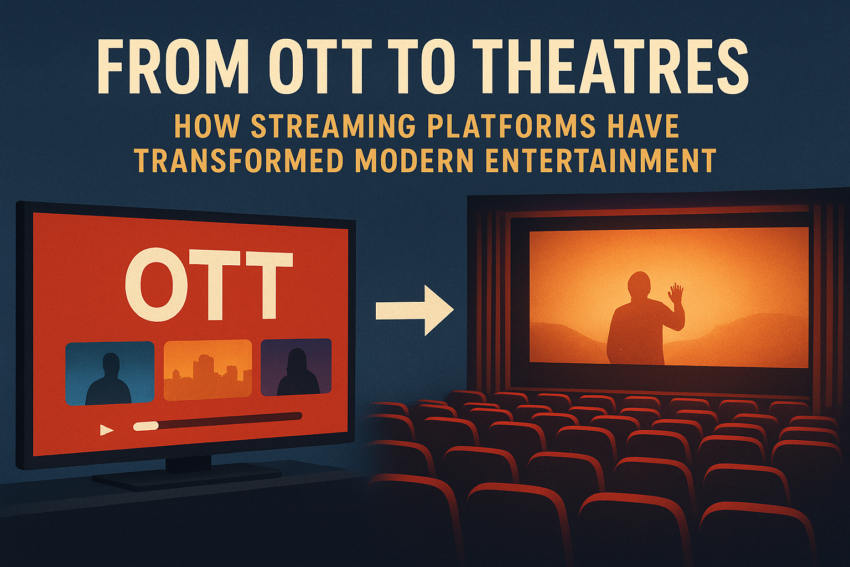The entertainment sector has always been characterized by change. From the earliest days of film to vibrant, colorful cinema, and from cable television to on-demand digital media, each transformation has altered how viewers consume stories. Of late, the rise of OTT (Over-the-Top) platforms such as Netflix, Amazon Prime Video, Disney+ Hotstar, and others has revolutionized entertainment consumption. These platforms have not just changed the viewing experience, but also reshaped the role of cinemas in the modern world.
This shift goes beyond just convenience—it indicates a change in audience behavior, storytelling formats, and the fundamental economics of the entertainment world.
The Rise of OTT Platforms
OTT platforms emerged as an alternative to traditional television and cinema. With the advent of high-speed internet and smartphones, people started seeking content they could view whenever and wherever they wanted. Services like Netflix and Amazon Prime gave audiences the ability to choose—what to watch, when to watch, and on which device.
Unlike traditional broadcasting, where content was scheduled, OTT brought personalization. Algorithms recommend content based on individual preferences, creating a tailored and engaging experience. This personalization, paired with affordability and ease, accelerated the popularity of streaming services.
The COVID-19 pandemic further accelerated this growth. With cinemas closed, audiences turned to OTT as their primary source of entertainment. Movies that once aimed for the big screen were released directly on streaming platforms, solidifying OTT’s dominance.
The Changing Role of Theatres
Despite the appeal of OTT, cinemas still retain a special charm. The experience of watching a movie on a large screen, with surround sound and a crowd of people, is something streaming cannot replicate. Blockbuster films like Pathaan, RRR, or KGF have shown that when a film is made for the big screen, audiences still flock to theaters.
However, the role of theaters is changing. Rather than being the sole entertainment hub, cinemas are now positioned as an event-based experience. Spectacle-driven films—high-budget action, fantasy, or superhero movies—continue to attract huge crowds. Meanwhile, OTT has taken over smaller-budget films and niche stories, which often struggle to find space in multiplexes.
This balance is reshaping how filmmakers plan their releases. Some projects are designed for theaters, while others are created specifically for OTT audiences.
Storytelling in the Age of Streaming
OTT has ushered in a new era of storytelling. Unlike theaters, where films must fit within a 2–3 hour window, streaming platforms promote long-form narratives. Web series, with multiple seasons and episodes, allow deeper character development and complex story arcs.
Genres that were once considered risky are now thriving on OTT. Dark thrillers, documentaries, regional cinema, and experimental dramas have found their place. Shows like Sacred Games, Paatal Lok, or Money Heist have proven that global audiences crave fresh and daring content.
Moreover, OTT platforms have democratized entertainment. Regional films and series now reach a global audience, breaking language and geographic barriers. A Tamil thriller or a Korean drama can trend worldwide, highlighting the universal power of storytelling.
Audience Behavior and Accessibility
One of the most significant changes brought by OTT platforms is how audiences consume content. The “binge-watching” culture, where viewers watch entire seasons in one sitting, has become commonplace. Unlike theaters, where the viewing schedule is fixed, OTT offers complete control to the audience.
Accessibility is another key factor. OTT platforms are available on smartphones, laptops, smart TVs, and even tablets. With affordable subscription models and regional content, entertainment is no longer limited to urban audiences. Rural and semi-urban areas have also embraced streaming platforms, expanding the overall market.
Economics of Entertainment
The transformation also extends to the economics of entertainment. Traditionally, a film’s success depended on its box-office collections. Today, OTT platforms pay substantial sums for streaming rights, often covering production costs prior to release.
This financial model reduces the risk for producers and gives filmmakers more creative freedom. Independent creators, who once struggled to find distribution for their films, now find opportunities through streaming services. For audiences, this means a broader range of content beyond the mainstream.
At the same time, theaters have responded by improving the cinematic experience. Multiplex chains now offer luxury seating, premium sound systems, and immersive technologies such as IMAX and 4DX to justify the cost of movie tickets.
The Future: Coexistence of OTT and Theatres
The debate over whether OTT will replace theaters is no longer relevant. Instead, both are likely to coexist, each serving distinct purposes. Theaters will remain the place for grand cinematic experiences—blockbusters, visual spectacles, and films that require collective viewing. OTT, on the other hand, will dominate everyday entertainment, niche storytelling, and personalized viewing.
In the future, hybrid models may emerge where films release simultaneously on both platforms, providing audiences with the flexibility to choose. Some industries are already experimenting with shorter theatrical windows, after which films quickly appear on streaming platforms.
Conclusion
The transition from OTT to theaters isn’t a competition but a reshaping of the entertainment landscape. Streaming platforms have empowered audiences with choice, variety, and convenience, while theaters continue to preserve the magic of the big screen. Together, they show how entertainment has evolved in the digital age.
As technology progresses and storytelling continues to evolve, audiences will remain the ultimate beneficiaries. Whether on a smartphone during a commute or in a crowded theater on a Friday night, the joy of experiencing stories will always be at the heart of entertainment.
FOR MORE INFORMATION VISIT TO THE LINKS BELOW:-
https://articlescad.com/understanding-master-betting-id-and-its-advantages-308823.html
https://www.bipluxuryapts.com/how-to-get-your-master-betting-id-on-madrasbook-within-minutes
https://workflowy.com/#/edb67471225f
https://pad.koeln.ccc.de/s/r-MIDvQRw
https://paste.chapril.org/?b233d363cceb31f6#BTp9XE2mtdHYZpPxtFomfxy9Y97ZMv89N7UgevbG1UeU
https://md.picasoft.net/s/UohbV_R_I
https://md.ctdo.de/s/Vn5nhYzoM
https://pad.degrowth.net/s/l1Vuee5hW
https://www.wowonder.xyz/read-blog/295135
https://blogosm.com/how-to-use-bonus-offers-and-promotions-as-a-master-id-user
https://pad.fablab-siegen.de/s/dtnaYiUvv
https://ulystar.in/blogs/35639/Multi-Sport-Betting-Access-Through-Your-Master-ID
https://md.yeswiki.net/s/IzXmkhtNq
https://webyourself.eu/blogs/1521207/Security-Measures-Behind-Master-Betting-ID-Platforms
https://ekonty.com/blogs/372535/Step-by-Step-Guide-to-Registering-and-Logging-In-with
